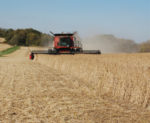Advertise Follow Us
Items Tagged with 'Corn stalks'
ARTICLES
No-Till Notes
Why Corn Stalks Won’t Decay And What To Do About It
No-tillers who find Bt stalks are hanging around a little too often should take a hard look at the ‘soil animals’ in their fields — they’re in the driver’s seat.
Read More
A Winning Formula To Break Down Tough Residue
Agronomist says a mixture of 28%, Thio-Sul, humates, sugar and water can help digest today’s tough corn stalks for better corn yields the following year.
Read More
No-Till Tradition, Passion For Change Fuel Miller Farms
Wisconsin no-tillers make use of cover crops, gypsum, winter wheat and precision ag to enhance soil biology and bump up no-till yields.
Read More








